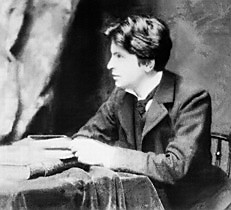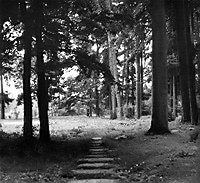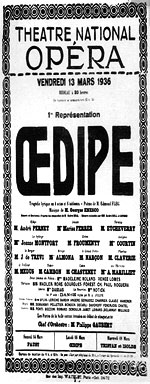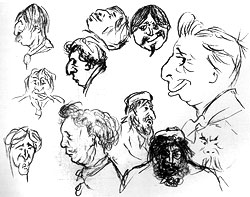“Stan’s particular achievement is his commitment for his great compatriot George Enescu. The fact that Enescu is performed far too little in these parts induced him to act as his prophet interpreter.“
SÜDDEUTSCHE ZEITUNG, Germany 2010 – Claus Regnault
Essay by Pascal Bentoiu (2005)
The composer George Enescu
George Enescu - a famous musician since his early childhood, highly appraised in Europe and in North America for both his performances as a violin virtuoso as well as his well-known Romanian Rhapsodies. And yet, this musician represents the typical case of a composer whose importance has never been fully understood even during his lifetime.
Enescu's revaluation has only just begun and is therefore confronting one difficulty or another. And it appears to be quite obvious that the musical qualities that turned Enescu into one of the most celebrated violinists of his era - an era adorned with names like Kreisler, Thibaud and Heifetz - and enabled him at the same time, quite on the contrary to the celebrities cited above, to become a great conductor and a fascinating teacher as well, are to be held responsible to have restrained his contemporaneity to rightly judge upon the true worth of his works.

The 20-year-old Enescu
There are however many reasons for such a misinterpretation (or, better yet, a very limited interpretation). For once there was the composer's legendary modesty itself, that might have had a part in that, as well as - possibly - a rather lax support from his editors, that did neither ensure the presence of Enescu's works in the concert halls and recording studios nor cared for a translation of the various essays and monographs on him into one of the major world languages. The fact that the composer belonged to a relatively small people speaking a beautiful but only scarcely spread language might also have. The quite important musicological input that the composer has generated in his homeland over the past 50 years has - in consequence - remained pretty much unknown to wider international circles.

In the garden of his estate in Tescani
One can divide Enescu's oeuvre grosso modo in two large periods. There is for once a time for introspecting and collecting, and then there is another time for harvesting the results of this previous period. The composer starts the series of his works with two remarkably mature pieces of chamber music, the 2nd Sonata for piano and Violin and the Octet for Strings. Enescu is not yet 18 years old when finishing the sonata and has not reached his 19th birthday when delivering the octet. Especially the latter is a contrapuntal chef d'oeuvre displaying an extraordinary architecture.
After having thereby reached the peak of his creativity on a highly concentrated level of utmost excellence, he starts a series of very interesting explorations, that will show one, two works at the utmost representing each direction. Each of these stylistic "regards" would have been suited for an entire period à la Strawinsky. We encounter an ultra romantic piece (the Symphonie concertante for Cello and Orchestra op.8), a part with neo-classical traits (the 1st Suite for Orchestra op.9), a piano cycle, that one could describe as belonging to a neo-classical style with strongly influenced by French impressionism (the 2nd Piano Suite op.10), then there are the two famous Rhapsodies op.11, displaying the picturesque charm of Eastern European national schools, the clearly neo romantic 1st Symphony op.13, the Dixtuor for Winds op.13, where a very thorough classical style meets with the reminiscence of imaginary folk music, and - last, not least - the 2nd Suite for Orchestra, a striking example of how to adapt neo baroque to modern musical ideas. And one must insist upon the fact that each of the works mentioned above is always forcefully stressing both Enescu's unmistakable personality and sensibility.

Poster for the premiere of
Oedipe in Paris, 1936
Up to here nothing seems out of the extraordinary. "We meet here" thus the remark of a an attentive observer, "with the familiar case of a composer who left us with a neither very large, nor very small heritage (summing it up, it can approximately be compared to that of his colleague and friend Ravel) with a diverse and interesting range, that will sooner or later find its own way to the hearts and minds of its listeners."
Unfortunately things do not appear to turn out this way. Most of the works presented above are only sporadically present in concert halls, on new recordings and broadcasting shows. I am naturally not referring myself to Enescu's own country (where his presence in culture and media is represented at an average level), but to the international concert life, where Enescu is not appearing with a regularity matching the true value of his works.
The explanation? The real explanation, not the usual ones due to more or less circumstantial elements? There is but one. Enescu's most important works are all displaying an unusual amount of musical information and density.

Enescu as a cartoonist: 2nd f. b. l. Richard Strauss
Slowly but unavoidably the composer George Enescu is starting to make his way up to his rightful place as one of the greatest authors of his time. 50 years after the death of this great musician he is finally not longer measured by his potential to be used as a propaganda tool, but by the number of enthusiastic listeners touched by his music. Their community is constantly becoming more and more numerous.
© Pascal Bentoiu
Pascal Bentoiu (born 1927) is living in Bucharest as a composer and musicologist. He has published numerous essays on Enescu, providing in 1984 one of the most important books on Enescu up to this day, Capodopere enesciene [Enescu's Masterpieces]. In 1990 he became the first president of the Society of Romanian Composers after the downfall of the communist regime, his large oeuvre includes operas, symphonical and chamber music. Pascal Bentoiu is the author of the article on Enescu in the recent edition of the encyclopaedia "Musik in Geschichte und Gegenwart" (Music in history and presence).
(C) Copyright of the original (Romanian) article by Pascal Bentoiu 2005, (C) Copyright of this translated text by the International Enescu Society 2005. All rights reserved.
